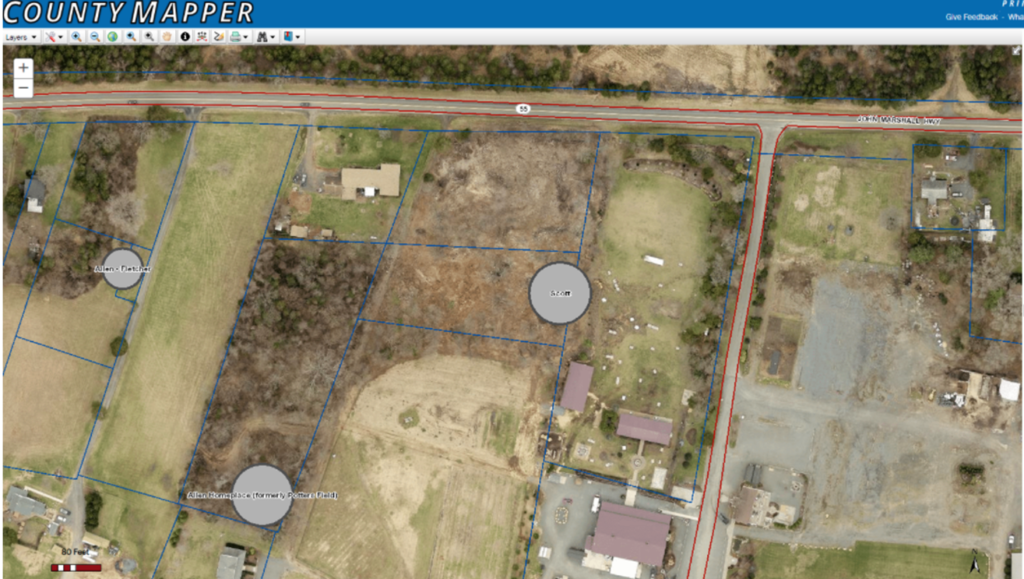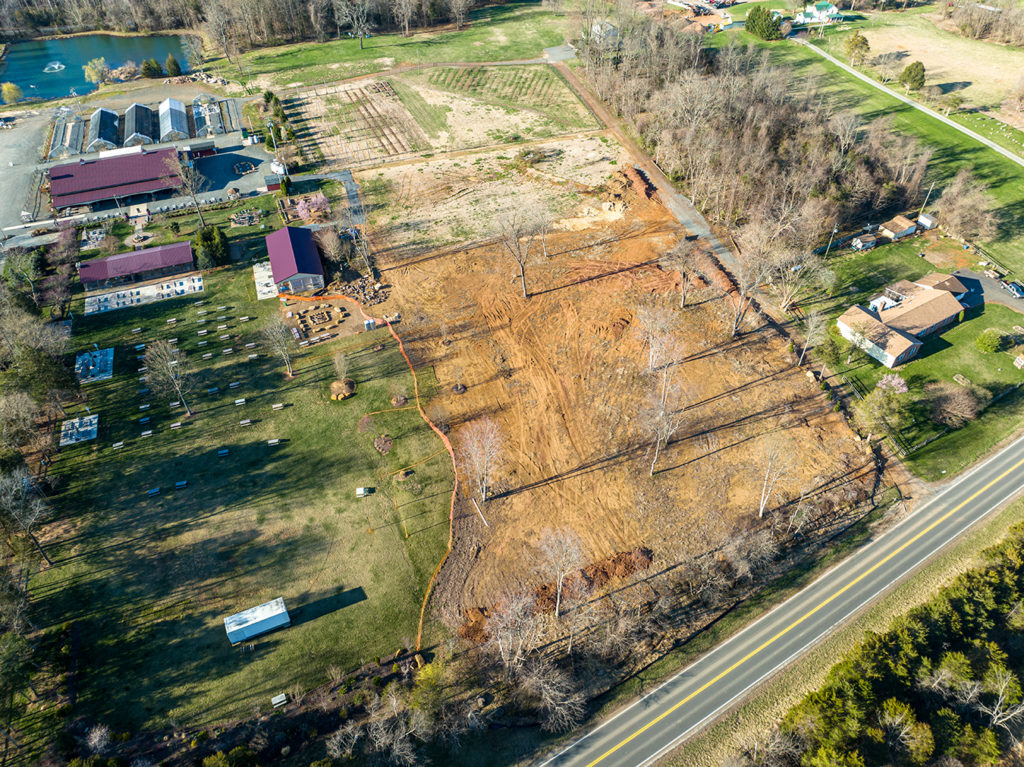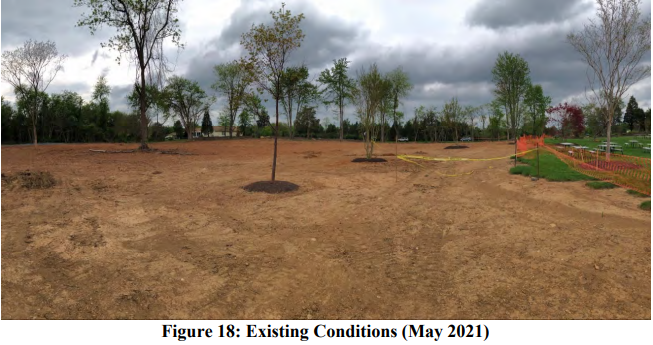Thoroughfare is a historic African American community founded by formerly enslaved people that lies along Rt. 55 in western Prince William County at the edge of Haymarket. Although the County has planned for the area to remain rural and it currently has rural zoning (A-1), Thoroughfare’s location at the edge of Haymarket has put the community’s future at risk. In particular, over the past several years, increasing development pressure has repeatedly threatened three African American cemeteries in the area: Scott Cemetery, Potters Field Cemetery and Allen/Fletcher Cemetery.

At most immediate risk is the oldest of the three, the Scott Cemetery, which holds an estimated 75-100 graves dating back to the 1800s. Scott Cemetery is documented in County records as early as 1966, and its location was reconfirmed with site surveys conducted by Ron Turner in 1996 and 2001. More information can be found here: https://historicprincewilliam.org/cemeteries/cemeteries-in-pwc/#s
In April 2021, in response to land clearing, earth-moving equipment, and attempts to cut off access to these cemeteries, a descendant of the Thoroughfare area named Frank Washington started an opposition group called Coalition to Save Historic Thoroughfare. The group kicked off its campaign with a press conference, during which members of Washington’s and other families buried in Thoroughfare spoke about the threat to the three cemeteries. Since then, the Coalition has participated in numerous outreach events, raising awareness and pushing the County to take action.
In response to the coalition’s efforts, the County purchased the two-acre site of the Potter Field (also called Peyton) Cemetery from landowner W.M. Tinder, Inc., protecting one of the three cemeteries from encroaching development. However, so far the County has denied the families burial rights in both active cemeteries, Potters and FletcherAllen. In January 2022, the County Human Rights Commission recognized Frank Washington and the Coalition to Save Historic Thoroughfare for their work.
PEC, along with the African American Heritage Association of Fauquier (AAHA), Prince William Conservation Alliance (PWCA), Coalition to Protect Prince William, and Southern Environmental Law Center (SELC), is assisting the Coalition with outreach, advocacy, and research on the history of the cemeteries, properties, and family lineage in Thoroughfare. We also encourage you to join us in supporting this important effort by writing to your elected officials and encouraging them to help protect the rest of historic Thoroughfare. We also encourage you to consider making a donation to the Coalition to Save Historic Thoroughfare’s GoFundMe page, which is raising funds for legal fees and legal representation. These funds are managed by Oakrum Baptist Church, a registered nonprofit in Broad Run, VA.
What’s happening with Scott Cemetery and the Potters Field Cemetery?

The Farm Brewery at Broad Run, which owns the land that Scott Cemetery sits on, encroached on the cemetery with land-clearing equipment in early 2021 and was subsequently cited with a zoning violation for clearing land without a permit shortly thereafter. However, the brewery owners claimed an agricultural exemption and continued to clear the area by removing trees and leveling the site.
In addition, the only access to Potters Field Cemetery, a road through the back of the brewery property, was cut off with a locked gate, mound of dirt and a no-trespassing sign. At the time, W. M. Tinder, Inc. owned the land surrounding Potters Field Cemetery and was attempting to block any new planned burials there.
In June 2021, the brewery landowners hired Wetland Studies and Solutions, Inc., an archeological firm, to investigate and delineate the Scott Cemetery. Wetland Studies and Solutions, Inc. developed a scope of work that included ground-penetrating radar and potential ground truthing if warranted. In September, the same firm was hired again to conduct the ground-penetrating radar and electromagnetic investigations study. However, the previously forested Scotts Cemetery area had already been cleared, leveled and compacted by heavy equipment prior to the study.
The investigation found only 11 anomalies in the soil structure indicating possible burial shafts or coffins, but these results are highly questionable for two reasons: 1) the site had been significantly disturbed, making identification of surface cemetery features and possible correlation with ground penetrating radar findings impossible; and 2) since the graves in the survey area likely date to the late 19th or early 20th century, any coffins or remains are likely to have been very deteriorated and therefore less visible to the radar.

In December 2021, the landowners hired Commonwealth Heritage Group (CHG), Inc. to do a very limited ground-truthing of only the 11 anomalies found; CHG found no evidence of gravesites. The results of these studies were presented to the community by County staff person Justin Patton, who said the landowners’ decision to engage CHG’s consultation services at that time represented a break with the scope of work and timeline the landowners previously set with the County. He explained that he took issue with many of the findings in the report. His two primary concerns were that the site had been completely disturbed prior to the study and that the ground truthing was limited to only the 11 anomalies; it excluded the nearby area where human remains might be present.
State law prohibits willful impact to cemeteries, and Prince William County has a Cemetery Preservation Ordinance that protects the identified cemeteries of the County (the Scott Cemetery being one of them). However, according to the County staff, until the landowner submits Site Plans or Subdivision Plans, that ordinance is not triggered. It is unclear why then the landowner completed this study other than to disprove the existence of the cemetery they had impacted and continued to disturb.
The Coalition to Save Historic Thoroughfare continues to challenge the landowners and push the County to take further action.
